Strengthening of Mg-6Al-1Zn Alloy via Simultaneous Loading and Aging
Abstract
:1. Introduction
2. Material and Experimental Procedures
2.1. Loading and Aging Procedure
2.2. Microstructural Characterization and Mechanical Test
3. Results
3.1. Effects of Simultaneous Loading and Aging on Microstructure
3.2. Effects of Simultaneous Loading and Aging on Mechanical Behavior during Subsequent Deformation
4. Discussion
5. Conclusions
- 1.
- Being different to aging after pre-strain, a larger quantity of the Al12Mg17 precipitates can be obtained in the AZ61 alloy subjected to simultaneous loading and aging in the same aging time. The applied stress during aging is beneficial for nucleation of the second-phase particles.
- 2.
- When the AZ61 sample was subjected to 175 MPa and then aged at 170 °C for 1 h and 3 h, respectively, no obvious increase in yield stress was observed. However, the simultaneous loading and aging shows an obvious effect on yield stress during subsequent deformation at room temperature, and it was found that there was an increase of ~42 MPa in yield stress compared with the pre-strained sample without aging. The second-phase particles generated during simultaneous loading and aging plays a role of obstacle to dislocation gliding, leading a hardening effect to AZ61 alloy. In addition, atoms segregated at the twin boundaries also contribute to the partial strengthening of the alloy under study.
Author Contributions
Funding
Institutional Review Board Statement
Informed Consent Statement
Data Availability Statement
Conflicts of Interest
References
- Czerwinski, J.A. Progress in twin roll casting of magnesium alloys: A review. J. Magnes. Alloy 2021, 9, 362–391. [Google Scholar] [CrossRef]
- Orozco-Caballero, A.; Lunt, D.; Robson, J.D.; da Fonseca, J.Q. How magnesium accommodates local deformation incompatibility: A high-resolution digital image correlation study. Acta Mater. 2017, 133, 367–379. [Google Scholar] [CrossRef]
- Kim, Y.J.; Lee, J.U.; Kim, S.H.; Kim, Y.M.; Park, S.H. Grain size effect on twinning and annealing behaviors of rolled magnesium alloy with bimodal structure. Mater. Sci. Eng. A 2019, 754, 38–45. [Google Scholar] [CrossRef]
- Khokhlova, J.A.; Khokhlov, M.A. 3d-visualization of magnesium strengthening mechanisms for a description of experimentally obtained data of alloying effect in Mg-Ga system. J. Magnes. Alloys 2020, 8, 546–551. [Google Scholar] [CrossRef]
- Nakasuji, Y.; Somekawa, H.; Yuasa, M.; Miyamoto, H.; Yamasaki, M.; Kawamura, Y. Quantitative kink boundaries strengthening effect of Mg-Y-Zn alloy containing LPSO phase. Mater. Lett. 2021, 292, 129625. [Google Scholar] [CrossRef]
- Prameela, S.; Yi, P.; Hollenweger, Y.; Liu, B.; Chen, J.; Kecskes, L.; Kochmann, D.M.; Falk, M.L.; Weihs, T.P. Strengthening magnesium by design: Integrating alloying and dynamic processing. Mech. Mater. 2022, 167, 10423. [Google Scholar] [CrossRef]
- Chelliah, M.; Singh, H.; Surappa, M. Microstructural evolution and strengthening behavior in in-situ magnesium matrix composites fabricated by solidification processing. Mater. Chem. Phys. 2017, 194, 65–76. [Google Scholar] [CrossRef] [Green Version]
- Nie, J.F.; Zhu, Y.M.; Liu, J.Z.; Fang, X.Y. Periodic segregation of solute atoms in fully coherent twin boundaries. Science 2013, 340, 957–960. [Google Scholar] [CrossRef] [PubMed]
- Xin, Y.; Zhou, X.; Chen, H.; Nie, J.F.; Zhang, H.; Zhang, Y.; Liu, Q. Annealing hardeninghang in detwinning deformation of Mg–3Al–1Zn alloy. Mater. Sci. Eng. A 2014, 594, 287–291. [Google Scholar] [CrossRef]
- Zeng, Z.R.; Zhu, Y.M.; Bian, M.Z.; Xu, S.W.; Davies, C.H.J.; Birbilis, N.; Nie, J.F. Annealing strengthening in a dilute Mg-Zn-Ca sheet alloy. Scripta Mater. 2015, 107, 127–130. [Google Scholar] [CrossRef]
- Volkov, A.Y.; Kliukin, I.V. Improving the mechanical properties of pure magnesium through cold hydrostatic extrusion and low-temperature annealing. Mater. Sci. Eng. A 2015, 627, 56–60. [Google Scholar] [CrossRef]
- Zhao, L.; Xin, Y.; Guo, F.; Yu, H.; Liu, Q. A new annealing hardening mechanism in pre-twinned Mg–3Al–1Zn alloy. Mater. Sci. Eng. A 2016, 654, 344–351. [Google Scholar] [CrossRef]
- Chen, H.; Song, B.; Guo, N.; Liu, T.; Zhou, T.; He, J. Dynamic recrystallization and grain refinement in extruded AZ31 rod during hot torsion deformation at 150 °C. Met. Mater. Int. 2019, 25, 147–158. [Google Scholar] [CrossRef]
- He, J.; Wu, L.; Sun, Q.; Zhai, L. Precipitation behavior and its effects on mechanical properties in a pre-twinned Mg-6Al-1Zn alloy. Mater. Trans. 2018, 59, 1389–1395. [Google Scholar] [CrossRef] [Green Version]
- Zhang, Y.; Liu, T.; Ding, X.; Xu, S.; He, J.; Chen, H.; Pan, F. The precipitation behavior of a pretwinned Mg-6Al-1Zn alloy and the effect on subsequent deformation. J. Mater. Res. 2014, 29, 2141–2146. [Google Scholar] [CrossRef]
- Chen, H.; Liu, T.; Zhang, Y.; Song, B.; Hou, D.; Pan, F. The yield asymmetry and precipitation behavior of pre-twinned ZK60 alloy. Mater. Sci. Eng. A 2016, 652, 167–174. [Google Scholar] [CrossRef]
- Moodov, K.D.; Al-Samman, T.; Molodov, D.A.; Korte-Kerzel, S. On the twinning shear of {102} twins in magnesium- Experimental determination and formal description. Acta Mater. 2017, 134, 267–273. [Google Scholar] [CrossRef]
- Inoue, K.; Kawahara, K.; Saito, M.; Kotani, M.; Ikuhara, Y. 3D arrangement of atomic polyhedral in tile grain boundaries. Acta Mater. 2021, 202, 266–276. [Google Scholar] [CrossRef]
- Dang, K.; Graham, J.; McCabe, R.J.; Taupin, V.; Tomé, C.N.; Capolungo, L. Atomistic and phase field simulations of three dimensional interactions of {10–12} twins with grain boundaries in Mg: Twin transmission and dislocation emission. Materialia 2021, 20, 101247. [Google Scholar] [CrossRef]
- Li, R.; Zhang, J.; Fu, G.; Zong, L.; Guo, B.; Yu, Y.; Su, Y.; Hao, Y. Different precipitation hardening behaviors of extruded Mg-6Gd-1Ca alloy during artificial ageing and creep processes. Mater. Sci. Eng. A 2018, 715, 186–193. [Google Scholar] [CrossRef]



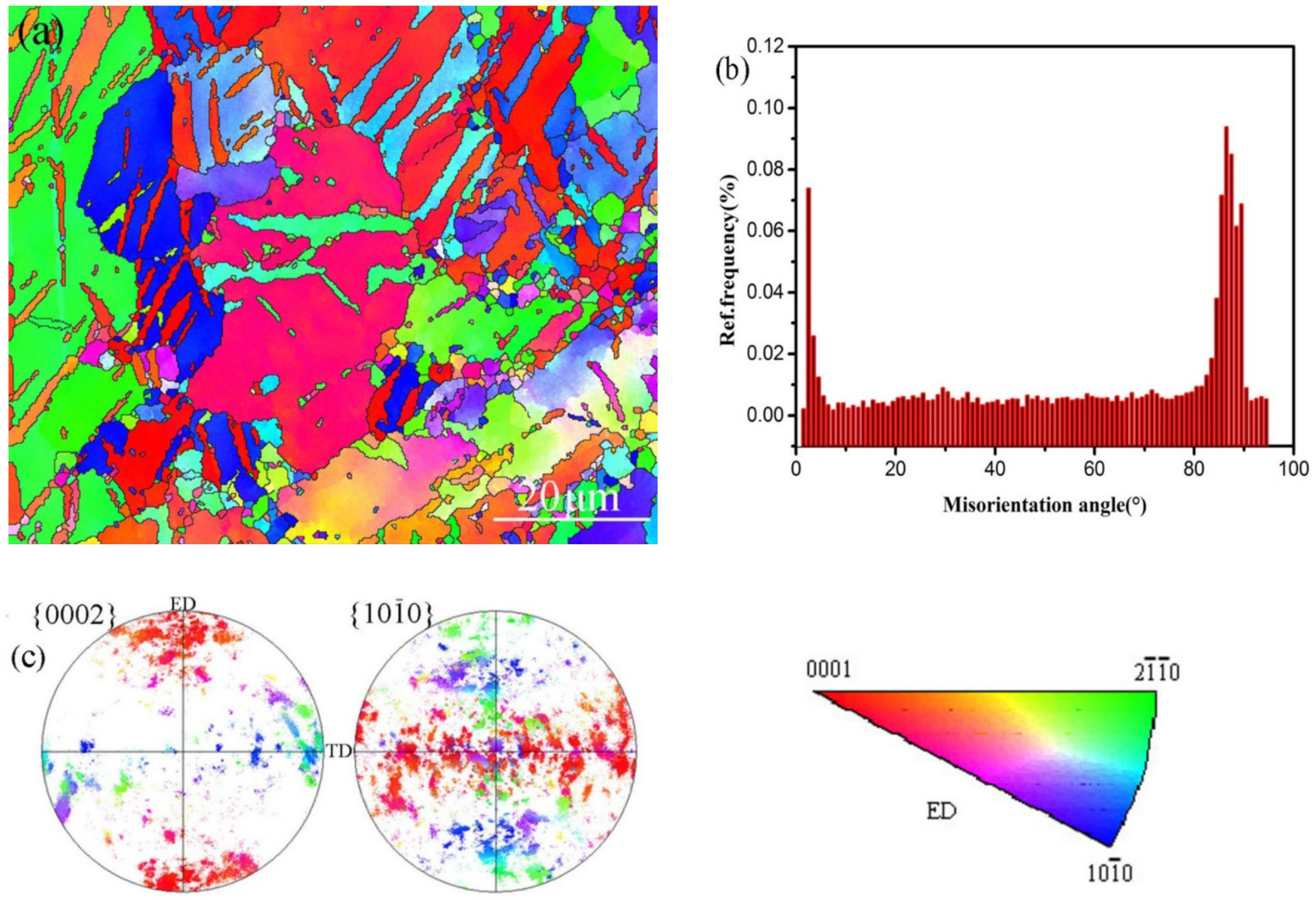

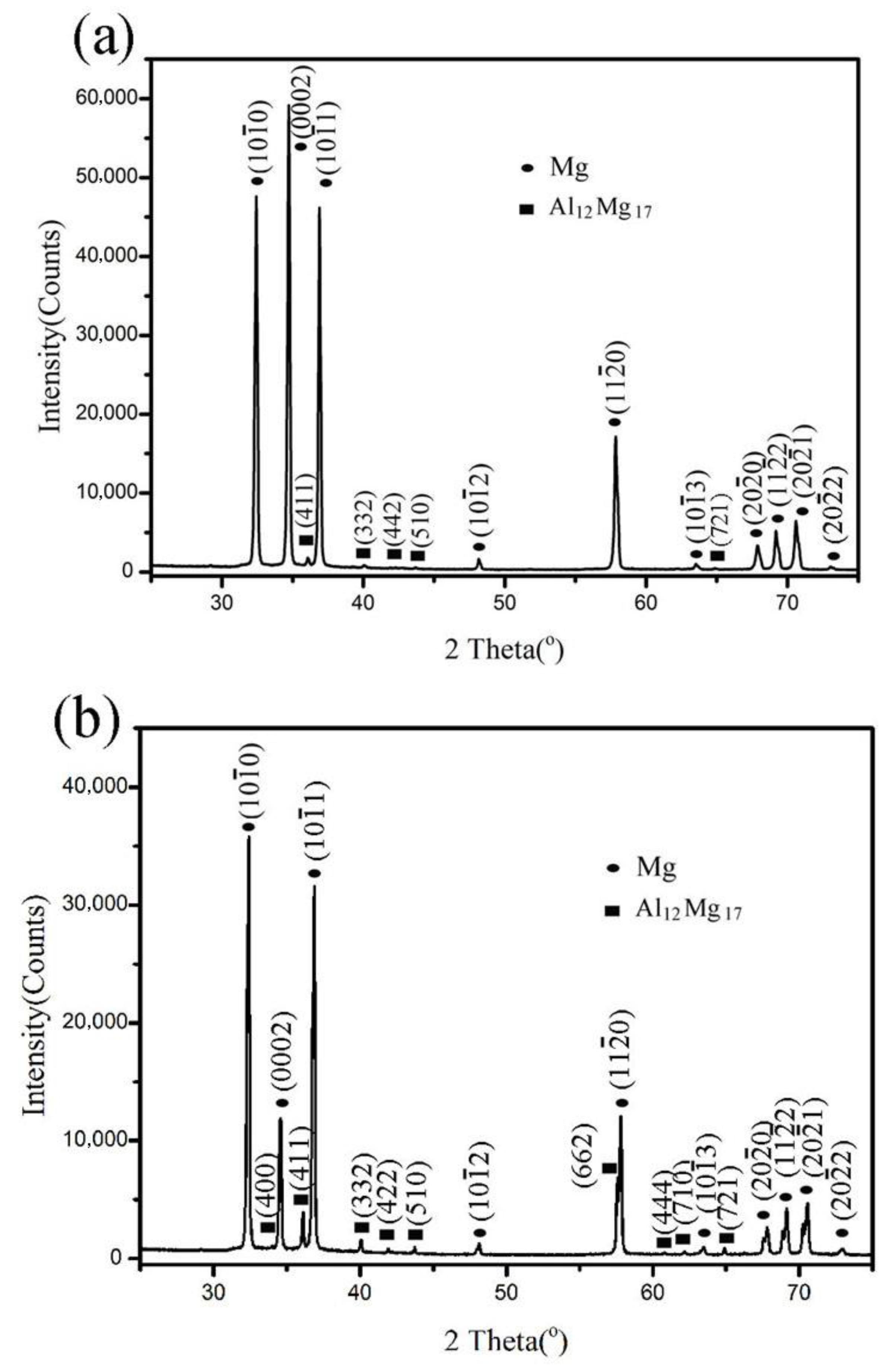
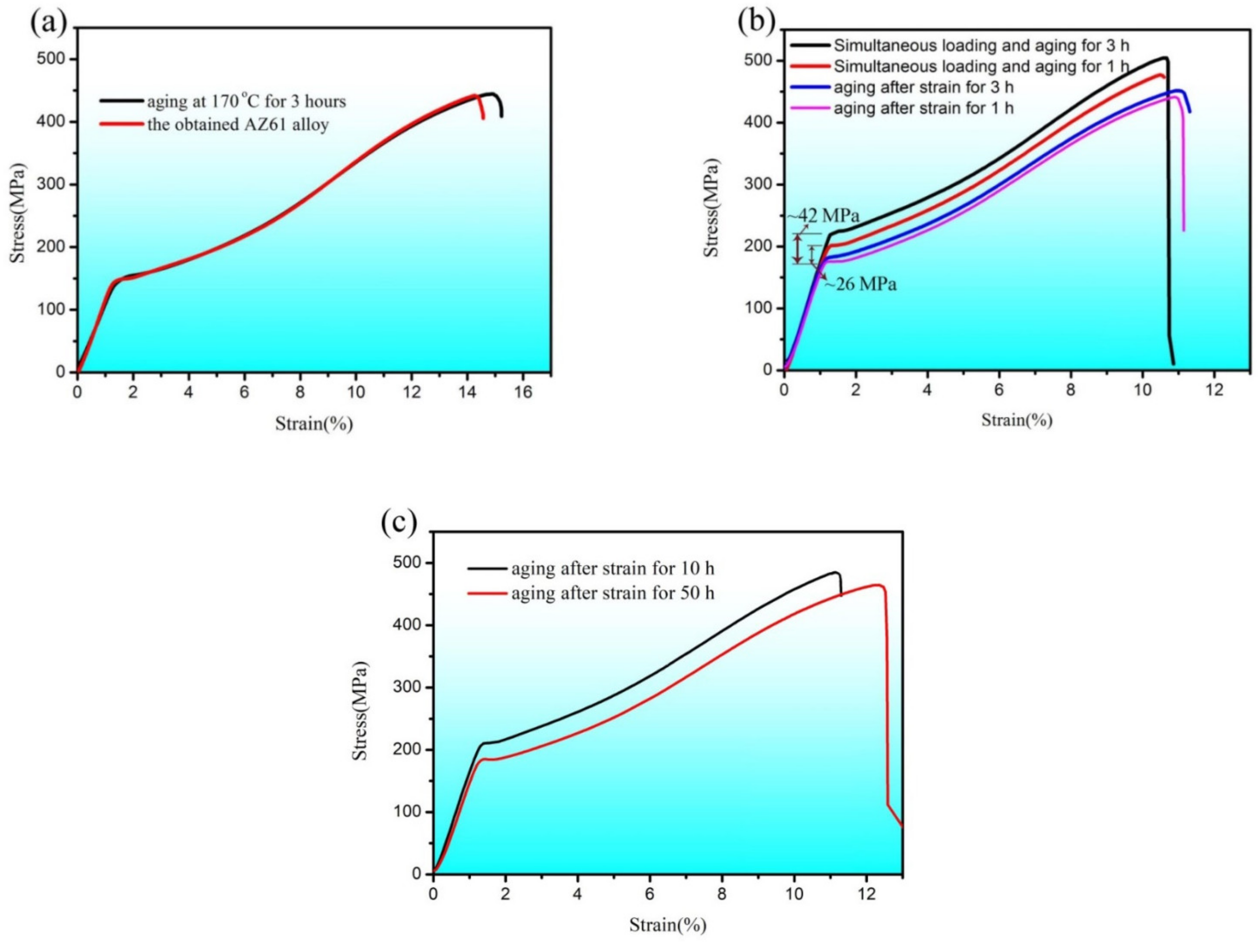
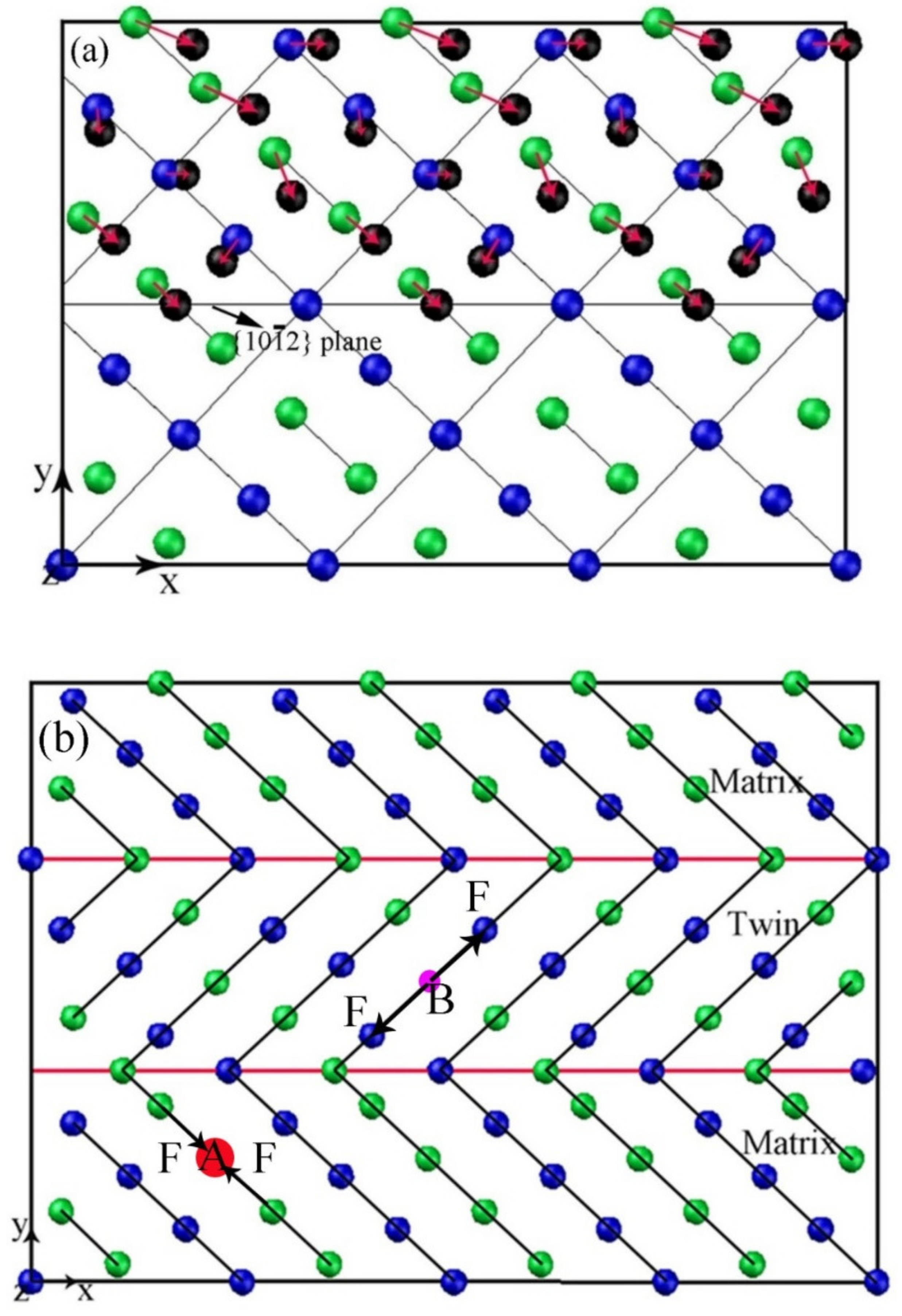
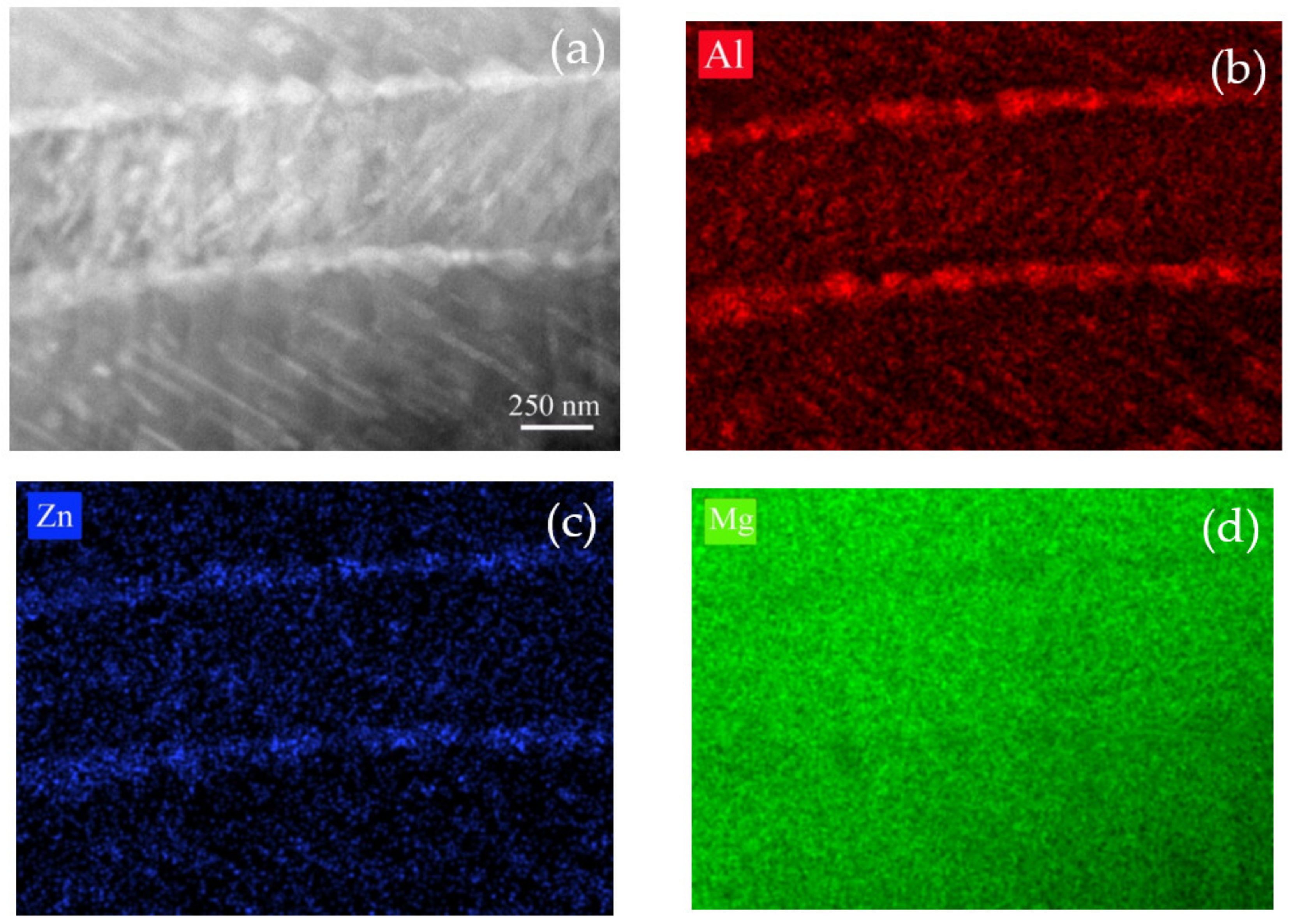

| Element | Al | Zn | Mn | Si | Ni | Fe | Cu | Mg |
|---|---|---|---|---|---|---|---|---|
| mass% | 5.9 | 1.0 | 0.3 | 0.0070 | 0.0006 | 0.004 | 0.003 | balance |
| Alloy | Process | Yield Stress |
|---|---|---|
| 1 | As-received | 155 MPa |
| 2 | 170 °C × 3 h | 155 MPa |
| 3 | 175 MPa and then 170 °C × 1 h | 175 MPa |
| 4 | Simultaneous loading and aging at 170 °C for 1 h | 201 MPa |
| 5 | 175 MPa and then 170 °C × 3 h | 175 MPa |
| 6 | Simultaneous loading and aging at 170 °C for 3 h | 217 MPa |
| 7 | 175 MPa and then 170 °C × 10 h | 206 MPa |
| 8 | 175 MPa and then 170 °C × 50 h | 181 MPa |
Publisher’s Note: MDPI stays neutral with regard to jurisdictional claims in published maps and institutional affiliations. |
© 2022 by the authors. Licensee MDPI, Basel, Switzerland. This article is an open access article distributed under the terms and conditions of the Creative Commons Attribution (CC BY) license (https://creativecommons.org/licenses/by/4.0/).
Share and Cite
He, J.; Wu, L. Strengthening of Mg-6Al-1Zn Alloy via Simultaneous Loading and Aging. Materials 2022, 15, 2782. https://doi.org/10.3390/ma15082782
He J, Wu L. Strengthening of Mg-6Al-1Zn Alloy via Simultaneous Loading and Aging. Materials. 2022; 15(8):2782. https://doi.org/10.3390/ma15082782
Chicago/Turabian StyleHe, Jiejun, and Lushu Wu. 2022. "Strengthening of Mg-6Al-1Zn Alloy via Simultaneous Loading and Aging" Materials 15, no. 8: 2782. https://doi.org/10.3390/ma15082782





